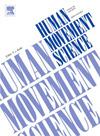超越单侧运动损伤:卒中后双侧力量控制和力量不对称在步态协调和跌倒中的作用
IF 1.9
3区 心理学
Q4 NEUROSCIENCES
引用次数: 0
摘要
下肢之间的协调是行走的一个基本方面,但它在中风后运动恢复中受到的关注有限。我们的目的是比较单侧和双侧力量损伤对步态协调的影响,并研究步态协调与卒中后跌倒发生率之间的关系。在中风成人(N = 22)和年龄相似的健康对照(N = 22)中,我们用相协调指数(PCI)测量了地上行走时的步态协调性。我们测量了单侧和双侧踝关节背屈肌的力量控制。通过视觉运动追踪时的力误差和每条腿的最大自主收缩力来量化单侧力损伤。通过相互相关系数、时间滞后和强度对称性测量双侧力损伤。我们记录了前一年中风患者跌倒的历史。与对照组相比,成年脑卒中患者PCI明显增加,相互关联系数降低,双侧力之间的滞后时间增加。卒中组瘸腿和非瘸腿的力误差均增加。强度对称性和相互相关系数解释了59.5%的PCI方差(p <;0.001)。然而,单侧力量损伤与PCI无关。据报道,中风患者以前的跌倒发生率为59.09%。有跌倒史的脑卒中幸存者的PCI明显高于无跌倒史的脑卒中幸存者(p <;0.01)。我们发现跌倒与PCI有显著关系(p <;0.05),因此步态协调性差与中风幸存者过去跌倒的发生率有关。目前的研究提供了新的见解,即双侧而非单侧力量控制的损伤会影响中风后地上行走的协调。具体来说,双侧踝关节力量和力量不对称之间的时间受损会对中风后的步态协调产生负面影响。步态协调受损会增加中风后跌倒的风险,从而影响中风患者的安全行动能力。本文章由计算机程序翻译,如有差异,请以英文原文为准。
Beyond unilateral motor impairments: Role of bilateral force control and strength asymmetry in gait coordination and falls post-stroke
Coordination between lower extremities is a fundamental aspect of walking, yet it has received limited attention in locomotor recovery post-stroke. We aimed to compare the impact of unilateral versus bilateral force impairments on gait coordination and examine the relationship between gait coordination and incidence of falls post-stroke. In adults with stroke (N = 22) and age-similar healthy controls (N = 22), we measured gait coordination with phase coordination index (PCI) during overground walking. We measured force control for ankle dorsiflexors in unilateral and bilateral conditions. Unilateral force impairments were quantified with force error during visuomotor tracking and maximum voluntary contraction force for each leg. Bilateral force impairments were measured with cross-correlation coefficient, time lag, and strength symmetry. We recorded the history of falls in the previous year for adults with stroke. Compared with controls, adults with stroke showed significantly increased PCI, decreased cross-correlation coefficient and increased time lag between bilateral forces. Force error of both paretic and non-paretic legs was increased in the stroke group. Strength symmetry and cross-correlation coefficient explained 59.5 % of the variance in PCI (p < 0.001). However, unilateral force impairments were not associated with PCI. Adults with stroke reported a previous fall incidence rate of 59.09 %. Stroke survivors with a history of fall showed significantly higher PCI relative to stroke survivors without a history of fall (p < 0.01). We found a significant relationship between falls and PCI (p < 0.05) such that poor gait coordination was related to past incidence of falls in stroke survivors. The current study provides novel insights that impairments in bilateral, but not unilateral force control influences coordination during overground walking post-stroke. Specifically, impaired timing between bilateral ankle forces and strength asymmetry negatively impacts gait coordination post-stroke. Impaired gait coordination elevates the risk for falling post-stroke, thereby compromising safe mobility in individuals with stroke.
求助全文
通过发布文献求助,成功后即可免费获取论文全文。
去求助
来源期刊

Human Movement Science
医学-神经科学
CiteScore
3.80
自引率
4.80%
发文量
89
审稿时长
42 days
期刊介绍:
Human Movement Science provides a medium for publishing disciplinary and multidisciplinary studies on human movement. It brings together psychological, biomechanical and neurophysiological research on the control, organization and learning of human movement, including the perceptual support of movement. The overarching goal of the journal is to publish articles that help advance theoretical understanding of the control and organization of human movement, as well as changes therein as a function of development, learning and rehabilitation. The nature of the research reported may vary from fundamental theoretical or empirical studies to more applied studies in the fields of, for example, sport, dance and rehabilitation with the proviso that all studies have a distinct theoretical bearing. Also, reviews and meta-studies advancing the understanding of human movement are welcome.
These aims and scope imply that purely descriptive studies are not acceptable, while methodological articles are only acceptable if the methodology in question opens up new vistas in understanding the control and organization of human movement. The same holds for articles on exercise physiology, which in general are not supported, unless they speak to the control and organization of human movement. In general, it is required that the theoretical message of articles published in Human Movement Science is, to a certain extent, innovative and not dismissible as just "more of the same."
 求助内容:
求助内容: 应助结果提醒方式:
应助结果提醒方式:


